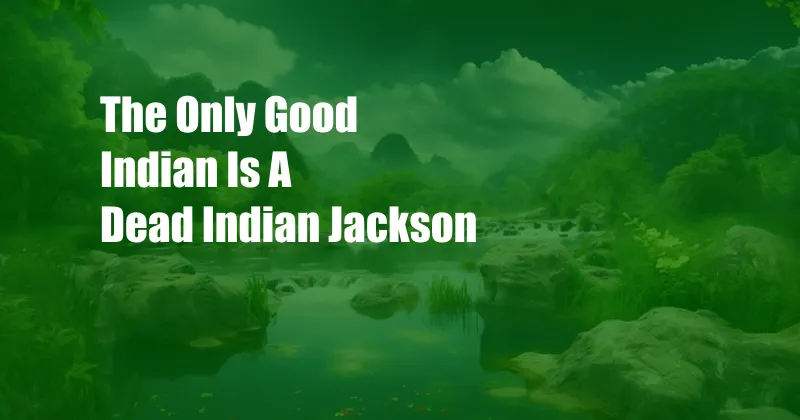
The Only Good Indian is a Dead Indian: A Phrase Rooted in Oppression
Growing up in a small town, I heard the phrase “The only good Indian is a dead Indian” whispered in hushed tones. It was a chilling sentiment that sent shivers down my spine, instilling a deep sense of fear and shame. As I delved deeper into Native American history, I uncovered the tragic origins and lasting impact of this hateful phrase.
The genesis of this phrase lies in the violent westward expansion of the United States. As white settlers encroached on Native American lands, conflicts erupted. The government’s response was often brutal, with bounties placed on Native scalps and campaigns of genocide wiping out entire tribes. This phrase, attributed to General Philip Sheridan, became a justification for the slaughter of Native Americans, reflecting the prevailing racist ideology of the time.
The Legacy of Oppression
The phrase “The only good Indian is a dead Indian” has left an indelible mark on Native American communities. It has been used to justify centuries of oppressive policies, including forced removals, boarding schools, and cultural suppression. Its lingering presence in our society continues to reinforce negative stereotypes and perpetuate racial discrimination.
The phrase serves as a constant reminder of the genocide and trauma experienced by Native Americans. It undermines their efforts towards self-determination and cultural preservation. It is not simply a historical relic but a living legacy of oppression that demands our attention and action.
Understanding the Phrase and Its Meaning
The phrase “The only good Indian is a dead Indian” is a manifestation of the dominant culture’s belief in the inferiority of Native Americans. It implies that Native Americans were inherently violent and deserved to be exterminated. This racist ideology was used to justify the seizure of their lands, the destruction of their cultures, and the killing of their people.
The phrase reduces Native Americans to a binary category: either they are “good” and dead or they are “bad” and alive. This oversimplification ignores the diversity and complexity of Native American cultures and histories. It denies their humanity and right to self-determination.
Trends and Developments
In recent years, there has been growing awareness of the harmful nature of the phrase “The only good Indian is a dead Indian.” Native American activists and scholars have worked tirelessly to challenge its use and promote a more respectful and accurate understanding of Native American history and culture.
Social media platforms have played a significant role in raising awareness about this phrase. Native American users have shared their experiences and challenged its use, leading to a broader understanding of its impact. Forums and discussion boards have also provided platforms for dialogue and education.
Tips and Expert Advice for Readers
As a blogger who writes frequently about Native American issues, I offer the following tips for readers:
- Educate yourself about Native American history and culture. This includes learning about the genocide, forced removals, and cultural suppression experienced by Native Americans.
- Challenge harmful stereotypes and misinformation about Native Americans. Speak out against racist language and actions.
- Support Native American organizations and initiatives. These organizations work to promote Native American rights, preserve their cultures, and educate the public.
By following these tips, you can help to create a more just and equitable society for all.
Explanation of Tips and Expert Advice
The tips I have provided are designed to help readers understand the harmful nature of the phrase “The only good Indian is a dead Indian” and to empower them to take action. By educating themselves about Native American history and culture, readers can challenge harmful stereotypes and misinformation.
Speaking out against racist language and actions is also essential. This sends a clear message that such behavior is unacceptable and will not be tolerated. Supporting Native American organizations and initiatives is another way to make a difference. These organizations work tirelessly to promote Native American rights, preserve their cultures, and educate the public.
FAQ
Q: What is the origin of the phrase “The only good Indian is a dead Indian”?
A: The phrase is attributed to General Philip Sheridan and was used to justify the genocide of Native Americans during the westward expansion of the United States.
Q: How has the phrase been used to justify oppression?
A: The phrase has been used to justify forced removals, boarding schools, and cultural suppression of Native Americans.
Q: What is the impact of the phrase on Native American communities?
A: The phrase serves as a constant reminder of the genocide and trauma experienced by Native Americans and undermines their efforts towards self-determination and cultural preservation.
Conclusion
The phrase “The only good Indian is a dead Indian” is a chilling reminder of the genocide and oppression experienced by Native Americans. It is a phrase that has been used to justify centuries of violence and discrimination. However, through education, activism, and solidarity, we can challenge its use and create a more just and equitable society for all.
Call to Action: I encourage you to learn more about Native American history and culture. Challenge harmful stereotypes and misinformation. Support Native American organizations and initiatives. Together, we can create a future where the phrase “The only good Indian is a dead Indian” becomes a relic of the past.
Are you interested in learning more about the history of this phrase? Share your thoughts in the comments below!